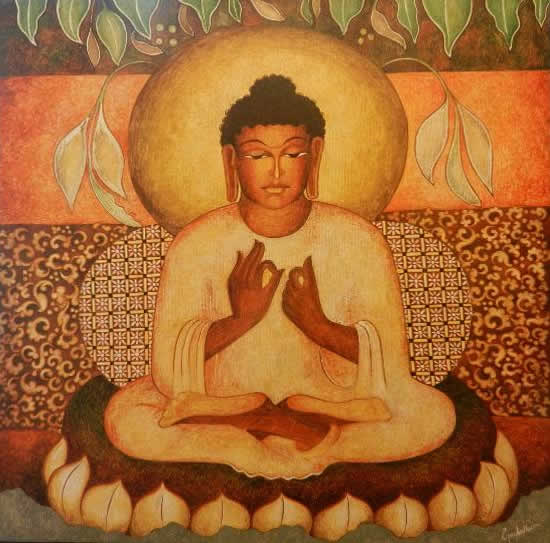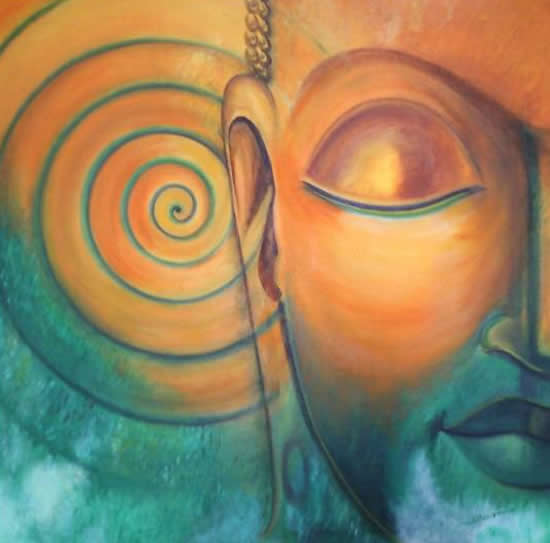
Buddha in Dhyanmudra, Painting by Artist Vijay Kulkarni
Acrylic on Canvas , 30 x 30 inches
Conception and birth
The Buddhist tradition regards Lumbini, in present-day Nepal to be the birthplace of the Buddha. He grew up in Kapilavastu. The exact site of ancient Kapilavastu is unknown. It may have been either Piprahwa, Uttar Pradesh, in present-day India, or Tilaurakot, in present-day Nepal. Both places belonged to the Sakya territory, and are located only 15 miles apart.
Gautama was born as a Kshatriya, the son of Śuddhodana, "an elected chief of the Shakya clan", whose capital was Kapilavastu, and who were later annexed by the growing Kingdom of Kosala during the Buddha's lifetime. Gautama was the family name. His mother, Maya, Suddhodana's wife, was a Koliyan princess. Legend has it that, on the night Siddhartha was conceived, Queen Maya dreamt that a white elephant with six white tusks entered her right side, and ten months later Siddhartha was born. As was the Shakya tradition, when his mother Queen Maya became pregnant, she left Kapilavastu for her father's kingdom to give birth. However, her son is said to have been born on the way, at Lumbini, in a garden beneath a sal tree. The day of the Buddha's birth is widely celebrated in Theravada countries as Vesak. Buddha's Birthday is called Buddha Purnima in Nepal, Bangladesh, and India as he is believed to have been born on a full moon day. Various sources hold that the Buddha's mother died at his birth, a few days or seven days later. The infant was given the name Siddhartha, meaning "he who achieves his aim". During the birth celebrations, the hermit seer Asita journeyed from his mountain abode and announced that the child would either become a great king (chakravartin) or a great sadhu.

Buddha, Painting by Artist Sharmila
Oil on Canvas , 30 x 30 inches
Renunciation and ascetic life
At the age of 29, Siddhartha left his palace to meet his subjects. Despite his father's efforts to hide from him the sick, aged and suffering, Siddhartha was said to have seen an old man. When his charioteer Channa explained to him that all people grew old, the prince went on further trips beyond the palace. On these he encountered a diseased man, a decaying corpse, and an ascetic. These depressed him, and he initially strove to overcome ageing, sickness, and death by living the life of an ascetic.
Accompanied by Channa and riding his horse Kanthaka, Gautama quit his palace for the life of a mendicant. It's said that "the horse's hooves were muffled by the gods" to prevent guards from knowing of his departure.
Gautama initially went to Rajagaha and began his ascetic life by begging for alms in the street. After King Bimbisara's men recognised Siddhartha and the king learned of his quest, Bimbisara offered Siddhartha the throne. Siddhartha rejected the offer but promised to visit his kingdom of Magadha first, upon attaining enlightenment.
He left Rajagaha and practised under two hermit teachers of yogic meditation. After mastering the teachings of Alara Kalama, he was asked by Kalama to succeed him. However, Gautama felt unsatisfied by the practice, and moved on to become a student of yoga with Udaka Ramaputta. With him he achieved high levels of meditative consciousness and was again asked to succeed his teacher. But, once more, he was not satisfied, and again moved on.